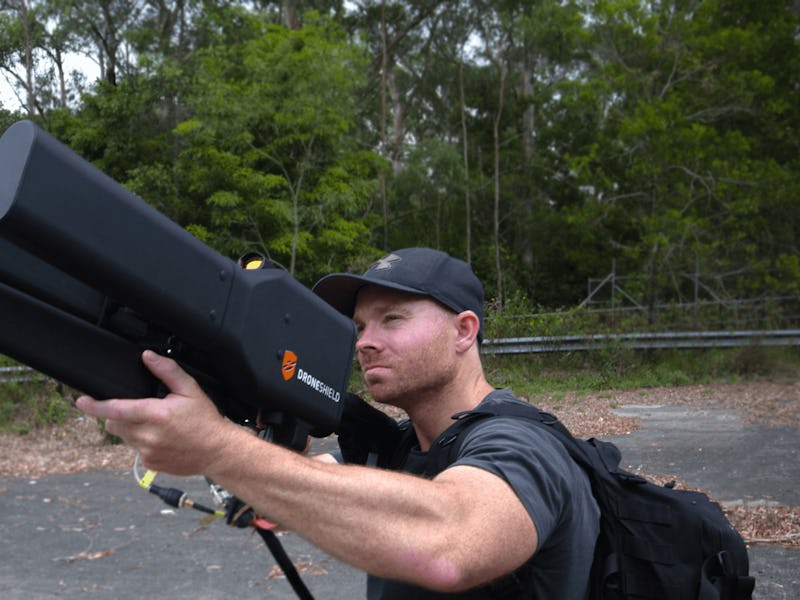This "Drone Gun" Can Safely Take Down a DJI Phantom
Bye-bye mechanical birdie.

Nothing’s more badass than eagles that hunt drones, but Dronegun comes pretty close. The device can take down unmanned aerial vehicles (UAVs) from 1.2 miles away, and it does so without damaging the UAV and its cargo, which means it won’t mistakenly activate a dangerous payload on the ground. Could this futuristic gun become the anti-drone defense mechanism of choice?
The gun, manufactured by a company called DroneShield, looks a bit like a cross between a video game weapon and a three-pronged electrical plug. Much of its tech is carried in a backpack, which makes it more portable than other anti-drone systems, and DroneShield said it was designed so anyone can use it without any training. All they have to do is point and shoot.
Once that trigger is pulled, Dronegun jams its target’s communications. This immediately stops any video feed the UAV was sending back to its controller — drones are often used for surveillance — and allows the shooter to either safely land the drone or make it fly back to wherever it came from. This is enabled by features that lead many drones to fly home if they lose contact with their pilot or to land if their communications are scrambled and they cannot use GPS.
Sorry, brah.
DroneShield CFO Oleg Vornik tells Inverse that Dronegun is a companion to the company’s other products, which are used to detect drones by monitoring an area’s noise levels and using the company’s “secret sauce” to figure out if a drone’s hum can be heard in the background. The system then signals that a drone has been detected and offers a location.
Vornik says the company has been working on these systems for the last three years. It’s shipped more than 200 units and works with distributors in 35 different countries. Many customers wanted something to help them respond to drones instead of merely detecting them, however, so the company started to develop what ultimately became the Dronegun about six months ago.
As UAVs become cheaper and more readily available, he said, it’s become easier for anyone to spy on or harm to others. But you can’t just shoot down every drone you see — this would inevitably lead to injured bystanders, very angry hobbyists, or accidentally activated payloads.
Some have turned to technology. Recently declassified video showcased a microwave gun made by Raytheon to fry entire drone swarms with a single shot. The device — which, to the joy of many Star Trek fans, is called the Phaser — can be used to either destroy or disable its targets. But it’s also very big, and it’s not clear when it might be used on the battlefield.
Vornik tells Inverse that Dronegun will compete with devices like the Phaser on price — it costs tens of thousands of dollars, which is cheaper than larger systems made by defense contractors — and portability. He also said that DroneShield made the Dronegun portable and gun-like because that’s what police officers, soldiers, and the product’s other intended users know.
Meanwhile, a growing number of groups are using eagles to attack drones. The birds are equipped with sharp claws, strong beaks, and the ability to meet their prey in mid-air while also bringing them back down to earth relatively gently. Dutch police were the first to use the birds against UAVs. Now the French Air Force is doing the same, and U.K. prisons could soon follow in their foot (claw?) prints to keep contraband from getting behind prison walls.
The French Air Force has said that it “sees eagles as the most effective and least expensive way” to handle drones. So how is DroneShield going to pitch the Dronegun when another company is busy pitching its eagles? Vornik laughs: “Well first I would say that you have to feed the eagle,” he said, “But you don’t have to worry about feeding the Dronegun.”
He continues, “When you see videos of these eagles they’re always going after little drones they can grab in their claws,” Vornik says. But he believes that trying to do the same to larger drones would be like throwing the eagle into a blender. “Our assessment is that this is like animal cruelty, and this just goes to show just how little competition there is in [the anti-drone] space.”
It's only available to law enforcement.
Dronegun is supposed to change that. DroneShield hasn’t started taking pre-orders for the device — Vornik said the company wants to finish testing on the product first — but it’s expected to debut soon. The device will first be sold to federal agencies (it’s not on sale to the public) but Vornik thinks others will eventually be able to purchase it too.